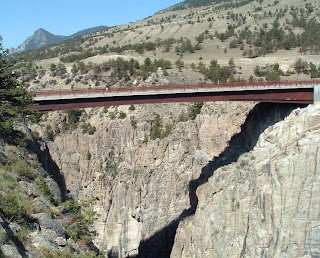If your western road trip vacation happens to take you to or near the fascinating and beautiful Yellowstone National Park, then you may have an opportunity to drive on the Chief Joseph Scenic Byway. This highway, which is located northeast of Yellowstone National Park, offers wonderful and very scenic views in the area of Idaho and Wyoming and was named in honor of the Nez Perce Indian Chief. It's a great area to visit while touring Yellowstone. The Chief Joseph Scenic Byway also has a very interesting story to tell about Chief Joseph and the Nez Perce and his relationship and conflict with the U.S. Government and military during the latter part of the 1800's.
Chief Joseph of the Nez Perce
 |
| Chief Joseph and family, 1880 |
The Nez Perce War
The Nez Perce War started very similar to the way the Sioux War of 1876-77 was ignited. Gold, and lot's of it. The Sioux went to war in part because of the massive invasion of white Americans into the Black Hills of Dakota Territory. This occurred in the early 1870's after George Armstrong Custer and others confirmed that gold was there in large quantities. With the Nez Perce it had to do with gold being discovered in Idaho and Montana in the 1860's. Just like the Sioux who had a treaty with the U.S. for ownership of the Black Hills, the Nez Perce had a U.S. treaty going back to 1855 which stipulated they were to have about 12,000 square miles of land in what are now the states of Idaho, Oregon and Washington. The treaty of 1855 also forbid encroachment by white settlers. All of this came to a screeching halt in 1860 when gold was discovered in Idaho. The result were some 5,000 prospectors and others immediately invading the Nez Perce homeland or reservation. In the period of 1876-77, about the time and shortly after the Sioux War to the east, everything came to a boiling point. The complaint from the Nez Perce perspective was that there were Indians killed by white settlers without any sign of prosecution. This just inflamed an already bad situation.
The Conflict Begins
 |
| Sunlight Bridge, Chief Joseph Nat'l Scenic Byway |
The Aftermath
The Nez Perce would not see their homeland again for many years. Eventually, and apparently against the agreement of the 1877 surrender, the Nez Perce ended up being transported to Indian Territory which is now the state of Oklahoma. One of the most historically remembered events during the surrender was Chief Joseph's speech which historians have named "I Will Fight No More Forever".
There are many side stories to the Nez Perce War and one has to do with Crazy Horse. The year 1877, one year after Custer's defeat at the Little Bighorn, Crazy Horse finally surrendered to the military near Fort Robinson in northeastern Nebraska. It wasn't an easy surrender and Crazy Horse had his doubts. With Sitting Bull in exile in Canada, Crazy Horse was considered the last of the hostile leaders to surrender. For whatever reason, Crazy Horse was urged by the army to join them in their fight against the Nez Perce. The Sioux and the Nez Perce were not on friendly terms at the time. This, Crazy Horse refused to do and he was pressured several times, not just once. The result caused a lot of friction between the newly surrendered Sioux leader and his army keepers. The relationship between Crazy Horse and the army really never improved during the short time he was put on a reservation. Neither side really trusted the other. The animosity for his refusal to help fight the Nez Perce and his refusal to travel to Washington DC at the behest of the army for perhaps political purposes, soured any relationship there was.
Our article , The Surrender of Crazy Horse, gives more detail about this historic event.
 |
| Big Hole Nat'l Battlefield, Idaho, courtesy NPS |
By most historical accounts, Chief Joseph was the strategist for the Nez Perce during the war. During the remainder of his life, Chief Joseph was outspoken about the injustice of United States policy toward the Nez Perce in particular and Native Americans in general. He petitioned presidents to this end including Theodore Roosevelt.
Chief Joseph was generally admired by many whites because of the way he treated prisoners, his concern for women, children, and the old, and because he had a history of buying supplies from ranchers and general stores rather than stealing them.
Chief Joseph died in 1904 and is buried near Lake Roosevelt National Recreation Area on the Confederated Tribes of the Colville Reservation and is part of Nez Perce National Historical Park. The park is outside Lewiston Montana and about 100 miles south of Spokane Washington.
(Photos are from the public domain)
View Larger Map

